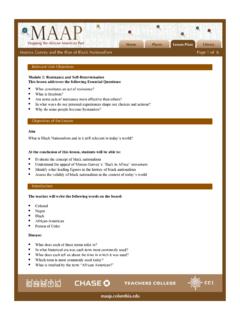Transcription of OVERVIEW - Kravitz Orthodontics
1 33 VOLUME L NUMBER 1 2016 JCO, correction of impacted lower sec-ond molars is challenging due to the limited access. Both nonsurgical1-6 and surgical7-15 treat-ment options have been reported. If the impacted molar is submerged deep below the soft tissue, surgical uprighting provides a safe and efficient solution with minimal tooth morbidity and a good long-term prognosis. Although the technique is most commonly applied to mesially angulated lower second molars, it can be used on other im-pacted teeth that have limited access or have failed to respond to standard bracket-and-chain early as 1956, Holland first discussed surgical repositioning, which he referred to as surgical Orthodontics .16 Peskin and Graber,17 as well as Johnson and Quirk,15 thoroughly reviewed surgical uprighting of lower second molars in the early 1970s. In 1995, Pogrel presented a landmark clinical study involving long-term observation of 22 surgically uprighted lower second D.
2 Kravitz , DMD, MSMARK YANOSKY, DMD, MSJASON B. COPE, DDS, PhDKIMBERLY SILLOWAY, DDSMEHRDAD FAVAGEHI, DDS, MSSurgical Uprighting of Lower second MolarsOVERVIEW(Editor s Note: In this regular column, JCO pro vides an OVERVIEW of a clinical topic of interest to orthodontists. Contributions and suggestions for future subjects are welcome.)Dr. SillowayDr. FavagehiDr. CopeDr. Yanosk yDr. KravitzDr. Kravitz is an Associate Editor of the Journal of Clinical Orthodontics ; an adjunct faculty member, Department of Orthodontics , Washington Hospital Center, Washington, DC; and in the private practice of Orthodontics at 25055 Riding Plaza, Suite 110, South Riding, VA 20152; e-mail: Dr. Yanosky is an Adjunct Assistant Professor, Department of Orthodontics , University of Alabama School of Dentistry, and in the private practice of Orthodontics in Birmingham, AL.
3 Dr. Cope is a Clinical Assistant Professor, Department of Orthodontics , Baylor College of Dentistry, Dallas; an Adjunct Associate Professor, Department of Orthodontics , St. Louis University, St. Louis; an Adjunct Clinical Associate Professor, Department of Orthodontics , Kyung Hee University School of Dentistry, Seoul, Korea; and in the private practice of ortho-dontics in Dallas. Dr. Silloway is in the private practice of oral and maxillofacial surgery in Centreville, VA. Dr. Favagehi is a Clinical Assistant Professor, Department of Periodontics, Virginia Commonwealth University School of Dentistry, Richmond, VA, and in the private practice of perio-dontics in Falls Church, VA. 2016 JCO, Inc. May not be distributed without permission. 2016 Surgical Uprighting of Lower second MolarsThis OVERVIEW provides a step -by- step guide to the procedure and the postsurgical orthodontic technique, with a discussion of case selection and potential uprighting, usually performed by an oral surgeon, is the luxation of an impacted tooth with-in its socket, using a straight elevator.
4 Prior to luxation, a minimal amount of buccal crestal bone is removed from around the crown, ensuring that the cementoenamel junction and root surfaces re-main covered. The tooth is tipped superiorly and distally with the elevator until the occlusal surface is approximately level with the occlusal plane. Most important, the molar is repositioned within its socket and rotated on its root apices to preserve the apical vessels (Table 1).Transalveolar transplantation is the surgical re-positioning of an impacted tooth within the den-toalveolus, but away from its The crown and some of the root are uncovered, and the new surgical site is prepared by funneling the bone with a bur. This technique is commonly used to correct impacted canines located high within the is the repositioning of a tooth from one site into an extraction site or a surgically prepared socket elsewhere in the mouth of the same Commonly used for premolars, this technique has been recommended to replace miss-ing teeth or teeth with poor both transalveolar transplantation and autotransplantation move the impacted tooth away from its socket, they increase the likelihood of periodontal healing complications and the need for root-canal therapy after surgery.
5 The greater the distance the root apex is moved, the greater the risk particularly if the tooth is mature and the root apices are impaction occurs in nearly 20% of the In the permanent dentition, the lower and upper third molars are the most commonly affected, followed by the upper canines and lower second Impaction of the lower second molars is relatively rare, occurring in only . of the population,23-25 but a higher incidence (2-3%) has been reported among orthodontic impaction occurs much more frequently in the mandible than in the maxilla, which may be attributed to the later development of the upper third These impactions tend to be unilateral24; Varpio and Wellfelt found more TABLE 1 DIFFERENCES AMONG SURGICAL UPRIGHTING, TRANSALVEOLAR TRANSPLANTATION, AND AUTOTRANSPLANTATIOND efinitionTeeth Commonly InvolvedRisk of Loss of VitalitySurgical uprightingRepositioning within the dentoalveolus and within the socketLower second molarsMildTransalveolar transplantationRepositioning within the dentoalveolus, but out- side the socketUpper caninesModerateAutotransplantationReposi tioning outside the dentoalveolus to a new locationPremolarsHigher35 VOLUME L NUMBER 1 Kravitz , Yanosky, Cope, Silloway, and Favagehia higher incidence of A higher inci-dence (1%) may also exist among Chinese popula-tions, presumably due to a larger tooth and TimingImpacted second molars are typically diag-nosed between 10 and 14 years of age.
6 Due to their late presentation, they are seldom the primary reason for an orthodontic referral. As an asymp-tomatic pathology, failure of eruption is more like-ly to be a secondary finding during orthodontic Clinical observation of one erupted lower second molar without the contralateral mo-lar may alert the orthodontist. In a preadolescent patient, panoramic evidence of a lower-third-molar follicle positioned on top of the developing second -molar crown may provide early warning of a future impaction (Fig. 1).The ideal time for surgical uprighting is dur-ing early adolescence, between 11 and 15 years of age, when the lower second molars are at one-half to two-thirds of their root development and the lower third molars have only partially developed (Fig. 2). Surgical uprighting prior to complete root formation of the lower second molars has been found to simplify the procedure and improve the long-term the right side,24 Cho and colleagues more on the Although both Bondemark and Tsiopa27 and Bacetti28 observed no differences according to gender, Varpio and Wellfelt noted a greater preva-lence in males,24 while Cho and colleagues found a greater prevalence in main causes of lower- second -molar impactions have been identified: ectopic position-ing, obstacles in the eruption path (impacted third molars, supernumerary teeth, cysts, or tumors), and failure of the eruption mechanism (ankylosis or dilaceration).
7 21 Posterior crowding is thought to be the most common cause of mesially angulated lower- second -molar impactions,29 in contrast to mesially angulated upper-first-molar impactions, which are typically associated with ectopic erup-tion causes also play a role. Hereditary factors may include systemic conditions or dental anomalies associated with impacted ,31 Among iatrogenic risks, the orthodontist may in-advertently impact a lower second molar while attempting to increase mandibular arch length with a lip bumper or an Arnold appliance,32 or during retraction of the mandibular dentition. Lower- second -molar impaction may be biologically re-lated to other genetic variations for example, patients with second -molar impactions have been shown to have a higher occurrence of morpho-logical tooth anomalies such as root deflections, invaginations, and guidance along the distal root of the first permanent molar a situation comparable to the upper canine moving down the distal root of the lateral incisor is needed for successful erup-tion of the second At some point during development, the tooth bud of an impacted second molar tips mesially, and the crown erupts in a me-sial direction, lodging against the distal promi-nence of the first molar.
8 Unerupted second molars are also associated with delayed eruption and ec-topic positioning of other The adjacent third molar is seldom missing, however, which is noteworthy since insufficient arch length has been cited as the primary reason for lower- second -molar ,33 To support this point, Caucasian patients with retrognathia have been shown to have Fig. 1 In panoramic x-ray of preadolescent pa-tient, third-molar follicle resting above occlusal table of developing lower second molar may warn of potential future above occlusal tableof second molar36 JCO/JANUARY 2016 Surgical Uprighting of Lower second MolarsFig. 3 Surgical uprighting in 14-year-old female. A. Third-molar incision and full-thickness flap performed by oral surgeon. B. Removal of third molar. C. Removal of buccal crestal bone. D. Luxation of impacted second molar. (Finger support on lingual aspect not shown for picture clarity.)
9 E. second -molar bracket etched and bonded. F. Light-cured wound dressing* placed occlusally and buccally for support. Vaseline on gloves eases handling of material. G. Occlusion checked to ensure elimination of vertical pressure from opposing teeth. H. At first orthodontic appointment, 14 days after surgery, wound dressing removed with scaler. I..018" nickel titanium archwire 2 Bilateral surgical uprighting in 15-year-old female, with orthodontic treatment initiated by patient's general dentist. A. At time of transfer, note influence of large lower third molars. B. Radiographic confir-mation of successful wire insertion through second -molar tubes. Note lower-third-molar extractions. C. Nine months after surgery, showing root parallelism and bone L NUMBER 1 Kravitz , Yanosky, Cope, Silloway, and Favagehipearance, and setting time than the traditional C o e - Pa k .**37 Finally, the occlusion should be checked to ensure that the opposing teeth are not contacting the material and delivering undesirable vertical forces (Fig.)
10 3G).The patient may experience minimal discom-fort with limited mouth opening for one to two weeks after surgery. Mild analgesics and prophy-lactic antibiotics are usually prescribed. Although postoperative infection is rare, 250mg or 500mg of penicillin adjusted by weight, four times a day for seven days, is suggested. A soft diet should be prescribed for one week to enable reattachment of the periodontal The first orthodontic appointment is scheduled seven to 14 days following the surgery. The periodontal dressing is easily removed with a scaler (Fig. 3H); no anesthesia is required. An .014" or (preferably) .018" nickel titanium wire is then threaded through the second -molar bracket to provide stabilization and improve alignment (Fig. 3I). Because the tissue distal to the second molar is often swollen, impeding visibility of the second -molar bracket, the clinician should extend the wire slightly beyond the bracket and confirm successful wire insertion with a panoramic orthodontic appointments are sched-uled every six to eight weeks.










